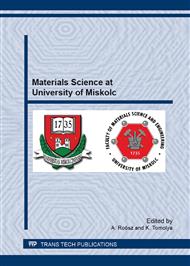p.3
p.10
p.20
p.30
p.37
p.42
p.48
p.57
Hf Particles Reinforced Cu-Zr-Al Amorphous Powder Produced by Milling
Abstract:
This research work dealt with production of amorphous powder with nominal composition of (Cu55Zr45Al10)97Hf3 (at%). Combining the mechanical milling and alloying, powder of crystalline Cu-Zr-Al alloy mixed with Hf elemental powder were milled in order to produce a homogenous and amorphous alloy powder The master alloy and the powders milled for different time were analyzed by X-Ray Analysis (XRD) and Scanning Electron Microscopy (SEM). Particle size distribution and hardness were controlled during milling and at the end of procedure. The milling caused dissolving of the hafnium. The 25 h milling time was the optimal to obtain the Hf containing powder with amorphous structure. However, elemental Hf traces with size below 3 µm were still observed in the powder. After 50 h of milling, such impurity elements as iron, nickel, chromium originating from milling tools (vial, balls) were detected.
Info:
Periodical:
Pages:
30-36
Citation:
Online since:
March 2013
Authors:
Keywords:
Price:
Сopyright:
© 2013 Trans Tech Publications Ltd. All Rights Reserved
Share:
Citation:


